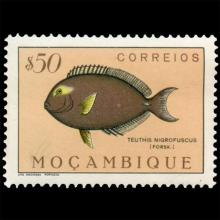NAMES
TAXONOMY
Mozambique
Issued:
Stamp:
Acanthurus nigrofuscus
Mozambique
Issued:
Stamp:
Acanthurus nigrofuscus
Mozambique
Issued:
Stamp:
Acanthurus nigrofuscus
Genus species (Animalia): Acanthurus nigrofuscus
Acanthurus nigrofuscus, also known as the lavender tang, brown tang, or spot-cheeked surgeonfish, is a tang from the Indo-Pacific and Hawaii. It commonly makes its way into the aquarium trade. It grows to 21 cm in length. Recently, a huge bacterium discovered in its intestine, Epulopiscium fishelsoni, has been found to grow as large as 600 by 80 μm, a little smaller than a printed hyphen, which controls the pH of its host's gut, thereby influencing its host's ability to digest food and absorb nutrients.
Acanthurus is a genus of fish in the family Acanthuridae found in the Atlantic, Indian and Pacific Ocean. They are found in tropical oceans, especially near coral reefs, with most species in the Indo-Pacific but a few are found in the Atlantic Ocean. As other members of the family, they have a pair of spines, one on either side of the base of the tail which are dangerously sharp.
Diet
The lavender tang is an herbivore that grazes primarily on benthic algae. In captivity, they will also feed on animal matter such as brine shrimp and mysis shrimp.
In the Aquarium
Tangs are very sensitive to disease in the home aquarium. However, if the tang is fed enough algae and the aquarium is properly maintained disease should not be a problem. It is usually necessary to quarantine the animals for a period before introducing them to the aquarium.
Adults range from 15 to 40 centimetres (5.9 to 15.7 in) in length and most grow quickly even in aquaria. When considering a tang for an aquarium it is important to consider the size to which these fish can grow. Larger species such as the popular Pacific blue tang surgeonfish (of Finding Nemo fame), Naso or lipstick tang, lined surgeonfish, Sohal surgeonfish and Atlantic blue tang surgeonfish can grow to 40 cm (16 in) and require swimming room and hiding places.
Many also suggest adding aggressive tangs to the aquarium last as they are territorial and may fight and possibly kill other fish.
Tangs primarily graze on macroalgae from genera such as Caulerpa and Gracilaria, although they have been observed in an aquarium setting to eat meat-based fish foods. A popular technique for aquarists, is to grow macroalgae in a sump or refugium. This technique not only is economically beneficial, but serves to promote enhanced water quality through nitrate absorption. The growth of the algae can then be controlled by feeding it to the tang.
Reference: Wikipedia, Integrated Taxonomic Information System
Photo: Rick Stuart-Smith


